Galleries
Join Us as We Dive with Trevor Paglen 70 Feet Underwater and See NSA-Tapped Cables
And suddenly, there it was—the Internet.

And suddenly, there it was—the Internet.

Brian Boucher

I’m flopping in my fins toward my first scuba dive in the ocean, accompanying artist Trevor Paglen on a mission to the ocean floor. We’re heading 70 feet down off the coast of Fort Lauderdale, Florida. The captain asks me how I’m feeling.
“Scared,” I say with a shrug, as if to say, How else would I feel?
“Remember,” he tells me, “Jacques Cousteau did not die from diving. He died an old man.”
When I hit the water, though, the anxiety is gone, and I am going slowly into the deep, hand over hand along a yellow rope.
See Pictures of the Art World Underwater
Paglen is taking a group of about ten divers to witness part of the physical structure of the Internet—fiber optic cables that run through trenches on the ocean floor, several of which come aground on the Atlantic coast of Florida. Like much of his work, the scuba mission is about making visible what typically remains unseen. The mostly well-heeled, art-loving participants have paid $500 each to join the artist. Among them are a San Francisco art dealer, a Sotheby’s specialist who’s in town from Asia, and a Los Angeles curator.
Over the course of his career, Paglen has directed our eyes toward sinister subjects like government torture and mass surveillance. Since the Internet cables are tapped by the National Security Administration, the dive exposes for the participants both the physical structure of the Internet and a site of government spying.
Ironically, this work of participatory, politically-motivated performance art takes place during the Art Basel Miami Beach fair, while many millions of dollars are changing hands a half-hour’s drive to the south, and while Thursday night revelers are no doubt waking up to crushing hangovers.
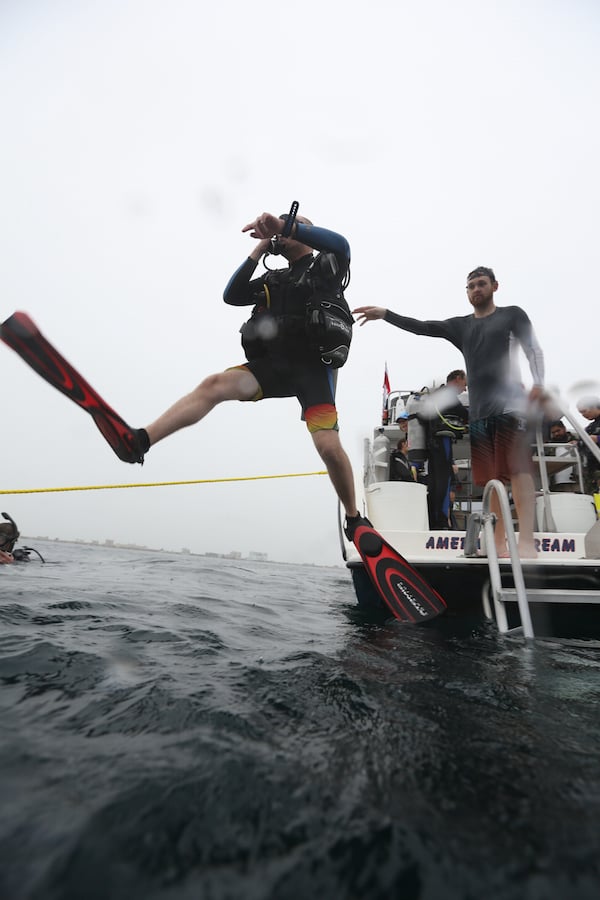
The artist takes the plunge.
Photo: Courtesy of Bill Lamp’l.
On the first dive, a sort of warm up, we visit an old tugboat, the Donald McAllister, which was submerged to help create an artificial reef. Orie Legum, my guide, a curly-haired, tanned man of about fifty, uses his flashlight to show me part of the interior of the 50-foot craft. Bright yellow fish dart about.
Captain Greg Grace has ferried us out to sea on the American Dream II, a 46-foot custom-built dive vessel, amid driving rain that has caused flooding all over the city. Thankfully, it lets up as we reach the site of our first dive, and the day gradually brightens.
“When we talk about ‘the Internet,’ we talk in abstract terms like ‘the cloud’ and ‘cyberspace,’” Paglen says to the group, all in wet suits, before we strap on our air tanks. The Internet is not just in the air, he says, but rather travels along the cables we’re headed to see. A crew member points out a cell phone tower back on land, and says it’s the destination of the one we will soon be looking at, which, Paglen says, conveys information to the US from Europe and serves as a pivot point for data to travel thence to South America. (Check out a map of the cables here.)
The housing for that cable, Paglen says, is approximately the thickness of the Pringles cans the crew has brought along to provide snacks.
“Most of that is armor, though,” he says. “The cable itself is about as thick as a hair.”
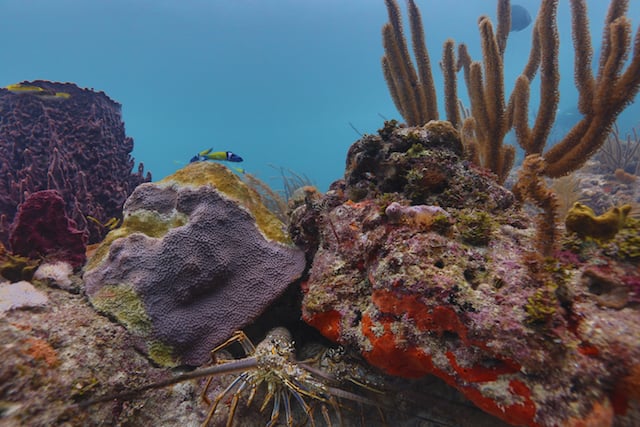
Underwater flora and fauna.
Photo Bill Lamp’l.
A Fascination with Secrecy
Paglen’s interest in the cables is, of course, not just that of a tech geek.
“As an artist, there’s nothing you’re going to look at that artists haven’t been looking at for centuries,” Paglen tells me and a couple of other divers. “The North Sea is the same sea that Caspar David Friedrich painted.” (Naturally, the example he uses is an aquatic one.) But just as you can’t swim in the same river twice, he adds that that sea has changed since Friedrich’s day, as it has seen so much history since the German painter studied it.
What Paglen is too modest to say is that partly by accident of being alive at this moment in time, and partly by dint of his own inventiveness, he has found something new to look at. Fiber optic cable now runs under that same sea Friedrich painted, but it didn’t then. And because it’s so new, a scant number of people have ever looked at the cable before. Friday’s trip was about letting us divers get up close and personal to this signifier of power and control, in a form of consciousness-raising.
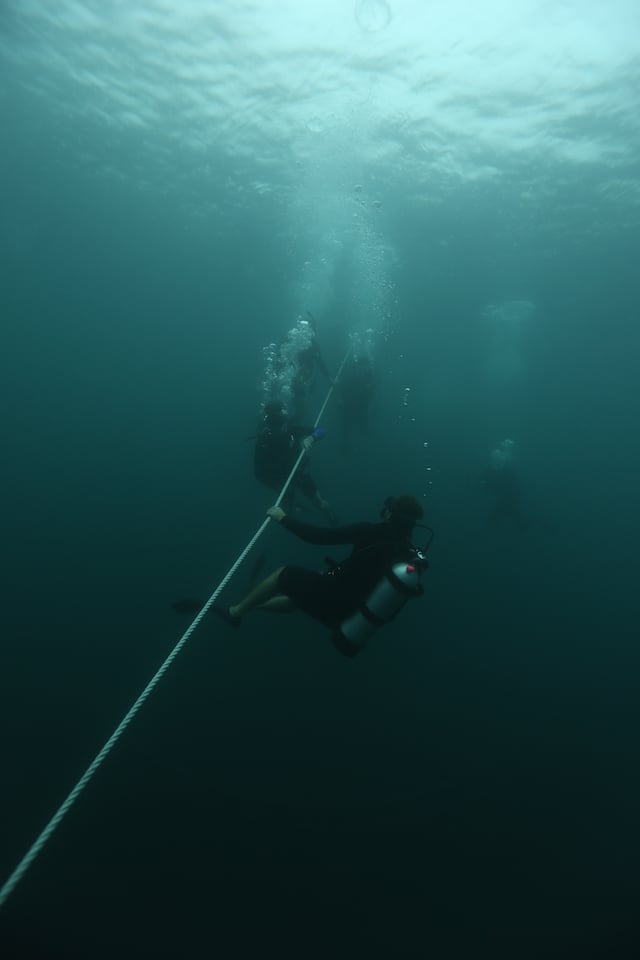
Divers descend toward the Donald McAllister.
Photo Bill Lamp’l.
Learning to Breathe
In order to join Paglen, I had to get certified as an open-water scuba diver, in this case via Scuba Schools International. After an online component of the training course, I attended an evening in-store class at Gotham Divers, in New York’s East Village, along with two couples who were planning vacation dives.
The course teaches you about the dangers of diving and how to avoid them. Among other hazards, various injuries can result from rapid changes in pressure as you descend or ascend; when you hit 10 meters, you’re under twice as much atmospheric pressure as on the surface, and three times as much at 20 meters, and so on. Going up and down properly is important.
You learn, for example, that you can blow out your eardrums by descending too fast without equalizing the pressure by plugging your nose and blowing out. You learn that if you were to run out of air and ascend while holding that one last breath, the air in your lungs would expand due to the decreasing water pressure as you climb, and, as the course’s language has it, “you suffer an overexpansion injury,” which sounds to me like a polite way of saying “your lungs explode.”
Then there was a pool session ten feet under the surface at Seahorse Fitness, on the Lower East Side, where I donned the wetsuit and fins and (really heavy!) air tank and breathed underwater for the first time.
It’s surprisingly unsettling and hard to get used to. You can communicate with your fellow divers only via gesture. Underwater, “thumbs up” does not mean “everything’s fine” or “well done”; it means “go up.”
Early on, when our instructor told us all to surface, I thought he meant we were doing a good job, and as everyone swam upward, I was left wondering, Where are they all going? (Approval, I would learn, is conveyed by hand claps.)
You have to learn all sorts of skills, for example how to share air with your diving buddy if she runs out—every tank is equipped with a spare hose for that purpose—and how to de-fog your mask by allowing some water in and then flushing it by blowing out through the nose.
Despite being exhausted after a stressful three-hour training session at the end of a full workday, I lay wide awake that night, thinking, What have I gotten myself into? This is the dumbest idea I’ve ever had. I’m going to die.

More underwater flora and fauna.
Photo Bill Lamp’l.
The final step toward certification was several dives at Dutch Springs, in Bethlehem, Pennsylvania, on a chilly November weekend. I hitched a ride with our instructor, John Rademacher, who, as it happens, is also a lawyer who works mostly with artists. (What are the chances?)
At Dutch Springs, a defunct quarry filled in with water serves as a training hub for diving students from throughout the Northeast. Old trucks and planes rest on the bottom, giving recreational divers something to explore. This time, we descended to wooden platforms at 27 feet, in 57-degree water, to practice our skills. Wet suits, thankfully, are quite warm.
I’m nervous by nature, and despite being watched over by professionals, each time we walked toward the water, I sent up a little prayer. Just don’t let me die this time, okay? But as the water closed above my head, I found out all over again that I could breathe.
My fellow divers on Friday sympathize with my anxiety. It’s like stage fright, one of them tells me. Moments later, splash, in we go.
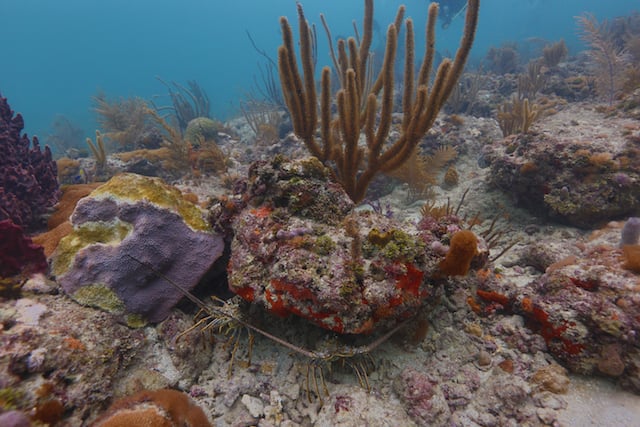
More underwater flora and fauna.
Photo Bill Lamp’l.
Seeing the Unseen
Paglen has long been interested in government secrecy. When I first learned of him, it was at his 2009 show “Black World,” at New York’s Bellwether Gallery, which included photographs of the dark realities the authorities aim to conceal.
Paglen was using powerful lenses to photograph, among other hidden places and things, airports and airplanes that the CIA was using to transport terror suspects. These people were often headed for “black sites,” prisons in countries where even the US’ nominal restrictions on torture don’t apply. He also got as close as he could to one of those, in Afghanistan, and took some pictures there. Similar photographs had also been compiled in a 2006 book, Torture Taxi: On the Trail of the CIA’s Rendition Flights, that Paglen co-authored with AC Thompson.
Word about Paglen spread further after Melville House released his book I Would Tell You But Then You Would Have to be Destroyed by Me: Emblems from the Pentagon’s Black World. That book published images of cloth patches that commemorate various secretive Pentagon operations and that, the artist says, the participants supplied to him.
Born in Maryland in 1974, Paglen now resides in Berlin. His interest in mapping the Internet neatly dovetails with his graduate studies; after he got an MFA from the School of the Art Institute of Chicago in 2002, he went on to earn a PhD in geography at the University of California at Berkeley. Since those early gallery shows, he’s been included in group exhibitions at venues from London’s Tate Modern to New York’s Museum of Modern Art, and has participated in prominent international exhibitions like the Istanbul Biennial (2009) and the International Center of Photography’s ICP Triennial (New York, 2013).
The scuba mission isn’t Paglen’s first foray into work focused on government spying. Video he shot was featured in Laura Poitras’ 2014 documentary Citizenfour. That film focused on whistleblower Edward Snowden, who revealed the US government’s massive and unconstitutional surveillance programs. In the movie, Paglen’s footage of government compounds, including NSA data storage facilities, is interwoven with scenes of Snowden being debriefed by Poitras and journalist Glenn Greenwald.
Those landscape videos were on view at a recent exhibition at his New York gallery, Metro Pictures. The show also offered a gesture aimed at evading the government’s all-seeing eyes. A small sculpture, Autonomy Cube (2014), consists of computer circuitry in a Plexiglas box. Those circuit boards created a wireless server that allowed gallery visitors to browse the web anonymously via the global, volunteer-run network known as Tor, maintained by privacy advocates.
Paglen hopes to expand on that small gesture and build similar networks at American museums. Those institutions often provide wireless networks for visitors, he told me, but that amenity comes at a price, in the form of data harvesting by the networks’ commercial providers. As the artist said during a tour of the exhibition that I attended, “Why shouldn’t museums, like libraries, be places that are truly private?”
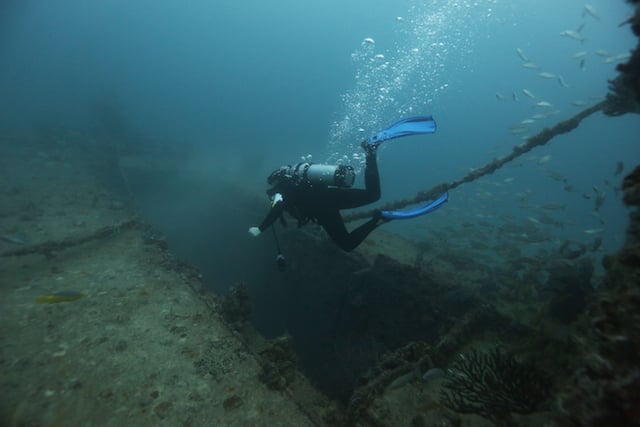
A diver descends into the hull of the Donald McAllister.
Photo Bill Lamp’l.
Security versus Liberty
Not everyone agrees with Paglen on that point, however.
Especially since the recent attacks in Paris, advocates for government surveillance have asserted that Snowden’s revelations have caused terrorists to adopt greater security measures. That position would seem to assume, of course, that ISIS was blithely communicating in plain language on open phone lines prior to Snowden’s leaks.
Security-minded politicians and commentators frequently make the “nothing to hide” argument, positing that the government needs to spy on us in order to get more data to protect us, and only those with something to hide need fear these measures. But the “Total Information Awareness” approach (as the George W. Bush administration’s Attorney General John Ashcroft called it) hasn’t quite worked. Government agencies are bogged down with so much noise that they can’t find the useful data. And post-9/11 attacks from Milan and Paris to San Bernardino, California, have proved the point.
Nevertheless, a recent bit by comedian John Oliver, on his late-night show “Last Week Tonight,” revealed that a shocking proportion of those his camera crew surveyed in Times Square one day didn’t know who Snowden was, didn’t think the government was spying on us, and heartily supported government surveillance.
They held on to their pro-spying position right up until it was pointed out to them that the naked photographs they text to their paramours are subject to government prying.
That, apparently, is a dick pic too far.
It’s against this depressing backdrop of ignorance, apathy, and complacency that work like Paglen’s is fruitfully viewed. We should all be looking as closely as we can at what those in power would like to hide. At its best, art helps us open our eyes wider, even when they’re behind a scuba mask.
The Final Dive
Our second dive takes us to only about 20 feet, which you reach in just seconds. When we get to the bottom, Legum points to the sandy ocean floor.
Plonk. There it is. The Internet.
It doesn’t look like much, as you might expect. I had somehow anticipated a pristine white plastic tube, but in fact it looks crusty, like it’s covered with sand-hued barnacles. Plants that look like purple pipe cleaners are either growing around it or actually stemming from its surface. I’m not sure which, because I don’t get quite close enough to tell, since Paglen has warned us, “Don’t touch it.”
Of course, one of my fellow divers promptly touches it. You might as well get your money’s worth, I suppose.
At that moment, we’ve achieved what we’ve come here to do.
We swim along the cable for a few minutes, as all the information—all of it—courses along beneath our fins. All the emails coming from European dealers to their colleagues at Miami’s twenty art fairs all happening at once, for example, and all the bank transfers from art buyers visiting from Rio de Janeiro and Mexico City, going to those dealers in London and Paris. All running through that wire.
Then we swim, just for fun, for one stupendous hour.
Everything that was so difficult during training—finding neutral buoyancy, neither rising nor sinking, and swimming around without excessive expenditure of energy—is suddenly easy.
Legum gathers us around him as he floats above a small hole in the ocean floor. He reaches in about arm deep and freezes for several seconds before pulling out a brown, spiny lobster about a foot long.
This kind doesn’t have claws, and he motions for us all, one by one, to stroke its sectioned back, which is surprisingly soft. Then he motions to a diver who has brought his own camera that he will let it go on the count of three, and the diver records it darting away.
Moments later, I find myself above another hole, staring into the eyes of a larger lobster, sitting atop what seem like dozens of spindly, bright yellow legs.
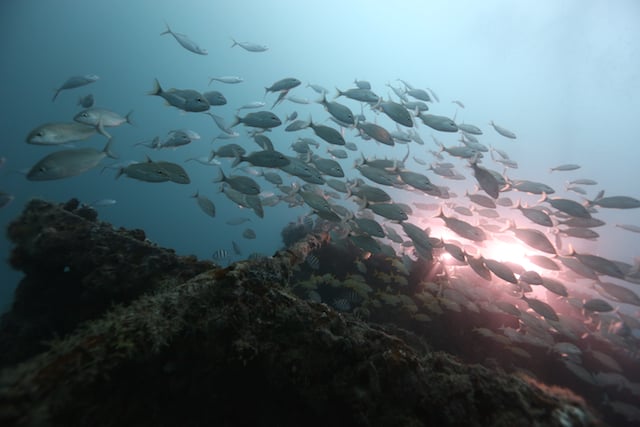
A school of fish near the Donald McAllister.
Photo Bill Lamp’l.
We see scorpion fish, a baby drum fish, yellow grunts, hermit crabs, sea snakes, and tiger fish.
Other than the Darth Vader hiss of air coming through the hose and then the burbling bubbles of my exhalations, it’s spellbindingly quiet under water. People ask, Isn’t it like being in space? Well, I don’t know, but it’s a lot like being under water. The thing is that it’s hard to describe what that’s like.
Even just a few feet down, the marine life is fabulous to me. Some plants are flat as a wafer! Others look like big rough-hewn ceramic vases, and fish hang out inside of their mouths! Some look like cacti! That black-and-white fish is just a few feet from me and completely unfazed by this big bubbling thing in a wet suit!
Finally calm and quiet, finally floating peacefully, finally swimming nearly without effort, I think, I love this. I need to change my life so that I can find a way to do this more.
Paglen has found a way. Like me, he got certified just to do the work he does. He’s headed soon to Hawaii and to Maui to see more cables.
Though Paglen’s work takes him to such exotic places and treats such controversial subjects, he’s remarkably disarming. Talking to him about his work, people often say, “You must be on some serious watch lists!”
“There’s nothing special about me,” Paglen replied when I said that to him. “They’re watching you too.”